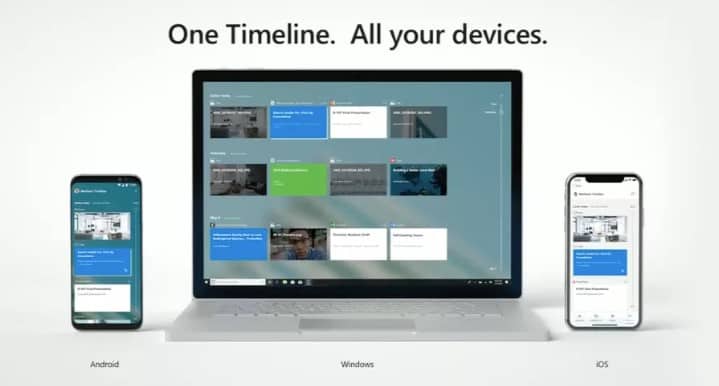
After two days of Microsoft Build keynotes, we’ve seen a lot. There were cloud APIs. Live coding demonstrations. One time Microsoft pulled away a wall to reveal a demo meeting room. It was truly a thrilling event.
But mixed within all of that were some exciting announcements: new Windows features, improvements for voice assistants, and helpful new cloud services. Much of it won’t be widely available until later this year, but here’s the most exciting stuff that Microsoft had to share.
YOUR PHONE SYNCS WITH WINDOWS
Microsoft previewed a new app called Your Phone that can sync Android phones and iPhones with Windows 10. You’ll be able to use the app to send text messages, access your photos, and view mobile notifications from your computer. That’s a huge convenience that ought to save you from pulling out your phone every few minutes. The feature goes into beta this week and is expected to launch publicly this fall.
CORTANA AND ALEXA WILL WORK TOGETHER
Sometime in the near future, you’ll be able to speak with Cortana through an Amazon Echo or reach Alexa through your Windows 10 PC. This partnership between Microsoft and Amazon, making each of their smart assistants available on one another’s platform, was first announced last year. But it wasn’t until today that we saw it in action.
On stage, representatives from Microsoft and Amazon demoed the integration on an Echo and a Surface. The integration isn’t perfectly natural: you have to say, “Alexa, open Cortana” or “Cortana, open Alexa” before you can speak with the other assistant — it’d be much more convenient if you could just say the assistant’s name to invoke them. That said, the assistants appeared to work as normal once they were open, and the integration should be helpful for people who have them set up to handle different tasks.
The feature remains in a “limited beta,” and it’s not clear if consumers are allowed in yet. Microsoft has a website up where you’ll be able to sign up to hear about progress on the Cortana / Alexa integration, and it’s presumably where you’ll want to go to hear about any wider beta.
TIMELINE FOR IOS AND ANDROID
Microsoft just introduced the Timeline with its latest update to Windows, and now the tool is about to get even more useful. Windows 10’s Timeline keeps track of all the apps you’re using and what you’re doing in them. You can open up the timeline to view your history and jump right back to where you were.
What’s powerful about the Timeline is that it can sync across Windows 10 devices. And now, Microsoft is bringing the Timeline to iOS and Android, too. So if you use the same apps on your phone and desktop, you’ll be able to pick something up on mobile that you started on a desktop. On Android, Timeline will be included as part of the Microsoft Launcher. On iOS, it’ll be a tab within the Edge browser.
For now, it’s largely Microsoft’s own apps that’ll sync their status between devices. But Microsoft is encouraging developers to start syncing their apps’ activity with the Timeline. Now that it’s available across platforms, there should be even more of a reason to add support.
MICROSOFT OFFERS DEVS MORE MONEY THAN APPLE OR GOOGLE
For years, it’s been standard practice for all the big app stores to take a 30 percent cut of the money an app brings in. That’s still largely true, but Microsoft is about to make a big change: in some circumstances, it’ll only take a 5 percent cut, leaving developers with 95 percent of the money they bring in.
That’s a huge incentive for developers to build apps for the Microsoft Store, which is still struggling to attract developers. The 95 percent cut will only be available for consumer apps (games not included), and Microsoft will take a bigger cut if it helped advertise the app. But that’s still a much better deal than app developers can get elsewhere. And if app store fees were holding them back before, this should resolve any outstanding issues.
WAY MORE POWERFUL TABS
The next version of Windows will have a big change to how windows work: instead of each window representing a single app, you’ll be able to create a “set,” which is a single window that contains tabs from different apps. So for example, you could have one window (or “set”) that contains a tab for Microsoft Word, alongside tabs from a few different websites in Edge.
The feature seems like a smart new option that should help people better organize their work. Microsoft is also looking into changing how Alt-Tab works, so that you can use the keyboard shortcut to switch through individual tabs, as well as windows.
KINECT IS ALIVE (AND IN THE CLOUD)
Here’s a surprise: Microsoft is keeping Kinect alive, just in a much different form than we know it today. Instead of being an accessory for the Xbox, Microsoft is turning Kinect into a cloud service. It sounds like developers will be able to send information from their own cameras and depth sensors up to Kinect in the cloud, have Microsoft process that information, and then send it back to the device.
The intention is to let hardware manufacturers create all kinds of Kinect-like cameras, which could be put to use in a much wider variety of ways than the failed Xbox accessory.
AND THERE’S A LOT MORE TO COME
Microsoft is going through a lot of changes right now, so we sat down with its CEO, Satya Nadella, to find out where it’s headed.
